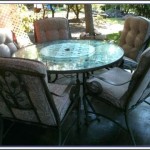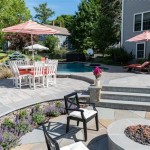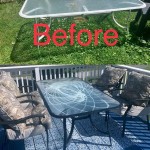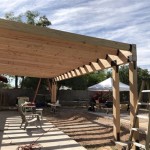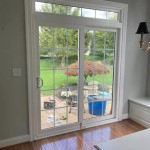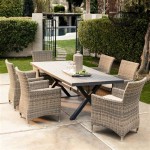```html
Enhancing Outdoor Living Spaces with Patio Covers in Denver
Denver, Colorado, a city known for its sunny days and vibrant outdoor culture, presents unique challenges and opportunities when it comes to creating comfortable and functional outdoor living spaces. The intense sun, occasional heavy snowfall, and variable temperatures demand careful consideration when selecting materials and designs for patio covers. Patio covers offer a multifaceted solution, providing shade, protection from the elements, and an aesthetic enhancement to homes.
The selection of a suitable patio cover involves weighing various factors, including the homeowner's budget, architectural style of the house, desired level of weather protection, and personal preferences. With a wide array of materials, designs, and functionalities available, understanding the nuances of each option is crucial for making an informed decision that will enhance the property's value and usability for years to come.
Key Considerations Before Installing a Patio Cover
Before embarking on the installation of a patio cover in Denver, several preliminary steps are essential. These considerations ensure that the project complies with local regulations, meets the homeowner’s specific needs, and integrates seamlessly with the existing landscape and architecture.
First, researching and obtaining the necessary permits is paramount. Denver's building codes and zoning regulations dictate the permissible dimensions, materials, and structural integrity of patio covers. Failure to comply with these regulations can result in costly fines and the requirement to dismantle the structure. The Denver Department of Community Planning and Development is the primary resource for obtaining information on permit requirements and submitting the necessary documentation. Engaging with a reputable contractor experienced in navigating Denver's permitting process can streamline this often-complex process.
Second, assessing the intended use of the patio space is vital. Will it primarily serve as a dining area, a relaxation zone, or an entertainment space? The intended use will influence the size, shape, and features of the patio cover. For instance, a dining area might benefit from a larger, more open design, while a relaxation zone might prioritize privacy and shade. Consider the placement of furniture, the need for lighting fixtures, and the desired level of enclosure when planning the dimensions and design of the patio cover.
Third, evaluating the existing architectural style of the house is critical for ensuring aesthetic harmony. The patio cover should complement the house's design, rather than clash with it. Consider the roofline, the exterior colors, and the overall style of the house when selecting the materials, shape, and finish of the patio cover. For example, a modern house might benefit from a sleek, minimalist design with clean lines, while a traditional house might be better suited to a more ornate design with natural materials.
Types of Patio Covers Available in Denver
Denver homeowners have access to a diverse range of patio cover options, each offering distinct advantages and disadvantages in terms of cost, aesthetics, durability, and maintenance. Understanding these differences is crucial for selecting the option that best aligns with the homeowner's needs and budget.
Solid patio covers provide complete protection from sun and rain, creating a fully shaded and sheltered outdoor space. Constructed from materials such as aluminum, wood, or composite, solid patio covers offer lasting durability and can be customized to match the house's architectural style. Aluminum patio covers are known for their resistance to rust and rot, requiring minimal maintenance. Wood patio covers offer a natural aesthetic but require regular painting or staining to prevent decay. Composite patio covers combine the durability of plastic with the look of wood, offering a low-maintenance and aesthetically pleasing option.
Lattice patio covers, also known as pergola-style covers, offer partial shade while allowing some sunlight to filter through. These covers are typically constructed from wood or aluminum and feature a grid-like structure that can be customized to control the amount of sunlight that penetrates. Lattice patio covers offer a more open and airy feel than solid covers, making them a popular choice for homeowners who want to enjoy the outdoors while still receiving some protection from the sun. The open design also allows for better ventilation, which can be beneficial during hot summer months.
Retractable patio covers offer the flexibility to adjust the level of shade and protection as needed. These covers typically consist of a fabric canopy that can be extended or retracted via a manual or motorized mechanism. Retractable patio covers are ideal for homeowners who want the option of enjoying the sun on cooler days or providing complete shade on hot days. The fabric canopy is typically made from durable, weather-resistant materials that can withstand the elements. Installation requires careful consideration of the structural support and the mechanics of the retractable mechanism.
Sail shades offer a contemporary and cost-effective solution for providing shade. These triangular or rectangular pieces of fabric are stretched between multiple anchor points, creating a visually appealing and functional shade structure. Sail shades are available in a variety of colors and sizes, allowing for customized designs that complement the house's architecture. While sail shades provide excellent sun protection, they offer limited protection from rain. Installation requires careful planning to ensure proper tension and stability.
Materials Used in Denver Patio Covers
The choice of materials significantly impacts the durability, aesthetics, and maintenance requirements of a patio cover. In Denver's climate, selecting materials that can withstand intense sun, snow, and temperature fluctuations is crucial for ensuring the longevity of the structure.
Aluminum is a popular choice for patio covers due to its resistance to rust, rot, and insect infestation. Aluminum patio covers are lightweight, durable, and require minimal maintenance. They can be powder-coated in a variety of colors to match the house's exterior. Aluminum is also a recyclable material, making it an environmentally friendly choice.
Wood offers a natural and aesthetically pleasing option for patio covers. Wood patio covers can be stained or painted to match the house's color scheme. However, wood requires regular maintenance to prevent rot and insect infestation. Pressure-treated wood is a common choice for patio covers as it is more resistant to decay. Regular sealing or staining is necessary to protect the wood from the elements.
Composite materials combine the look of wood with the durability of plastic, offering a low-maintenance and long-lasting option for patio covers. Composite patio covers are resistant to rot, insect infestation, and fading. They do not require painting or staining, making them a convenient choice for homeowners. Composite materials are available in a variety of colors and textures to mimic the look of natural wood.
Fabric is commonly used for retractable patio covers and shade sails. Fabrics used in these applications are typically treated to be water-resistant, UV-resistant, and fade-resistant. Acrylic fabrics are a popular choice due to their durability and resistance to mildew. Mesh fabrics allow for airflow while providing shade, making them a comfortable option for hot climates. The choice of fabric will depend on the desired level of shade, weather protection, and aesthetic appeal.
Polycarbonate is a durable and transparent plastic material that can be used for solid patio covers. Polycarbonate panels offer excellent light transmission while providing protection from the elements. They are also impact-resistant, making them a good choice for areas prone to hail. Polycarbonate panels are available in a variety of thicknesses and tints to control the amount of light that penetrates. They are also relatively lightweight, making them easier to install than some other materials.
Glass, either tempered or laminated, can also be used in the construction of patio covers, especially for creating enclosed sunrooms or more permanent structures. Glass provides unobstructed views and allows for ample natural light. Tempered glass is stronger and more resistant to breakage than standard glass. Laminated glass consists of two layers of glass bonded together with a layer of plastic in between, making it even stronger and safer. Glass patio covers can create a luxurious and comfortable outdoor living space, but they are typically more expensive than other options.
The decision regarding which material to use depends heavily on the homeowner's aesthetic preferences, budget constraints, and tolerance for maintenance. Consulting with a professional contractor can help navigate the numerous options and ensure the best choice for the specific Denver property.
```
Wooden Patio Cover Contractors In Denver Decks

Wooden Patio Cover Contractors In Denver Decks

Patio Covers Meraki Outdoor Living

Denver Patio Covers

Patio Covers Meraki Outdoor Living

Denver Patio Covers Wood Metal Vinyl Picking The Right Material

Denver Patio Covers

Louvered Patio Covers

Upgrading Your Retractable Patio Cover Struxure Devner 303 529 7819

Wooden Patio Cover Contractors In Denver Decks

